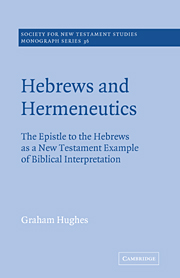 Hebrews and Hermeneutics
Hebrews and Hermeneutics The most immediately obvious expression of the hermeneutical question lying behind the epistle is contained in the use made by the writer of the Old Testament in his quotations. That is why almost invariably studies of the hermeneutical principles of the author have been confined to this particular field of investigation.
Attention has regularly been given to the singularly dynamic way in which the scriptures function for this Christian writer: ‘When he uses any word to introduce a quotation he employs words expressing diction … The present tense is preferred to the past tense, active forms to passive.’ ‘What has been said is also being said.’ In fact this observation simply raises in an especially clear and precise form the dialectic which we have said is the distinguishing mark of the relationship between the covenants. In this particular case the question takes the form: how in one context can the scriptures of the Old Testament function so immediately as a vehicle for the Word of God while in other contexts the covenant which those same scriptures enshrine is unceremoniously dismissed as outmoded?
It is true that we have to do here with the web of problems raised by the writer's citations from, and exegesis of, the Old Testament.
To save this book to your Kindle, first ensure [email protected] is added to your Approved Personal Document E-mail List under your Personal Document Settings on the Manage Your Content and Devices page of your Amazon account. Then enter the ‘name’ part of your Kindle email address below. Find out more about saving to your Kindle.
Note you can select to save to either the @free.kindle.com or @kindle.com variations. ‘@free.kindle.com’ emails are free but can only be saved to your device when it is connected to wi-fi. ‘@kindle.com’ emails can be delivered even when you are not connected to wi-fi, but note that service fees apply.
Find out more about the Kindle Personal Document Service.
To save content items to your account, please confirm that you agree to abide by our usage policies. If this is the first time you use this feature, you will be asked to authorise Cambridge Core to connect with your account. Find out more about saving content to Dropbox.
To save content items to your account, please confirm that you agree to abide by our usage policies. If this is the first time you use this feature, you will be asked to authorise Cambridge Core to connect with your account. Find out more about saving content to Google Drive.